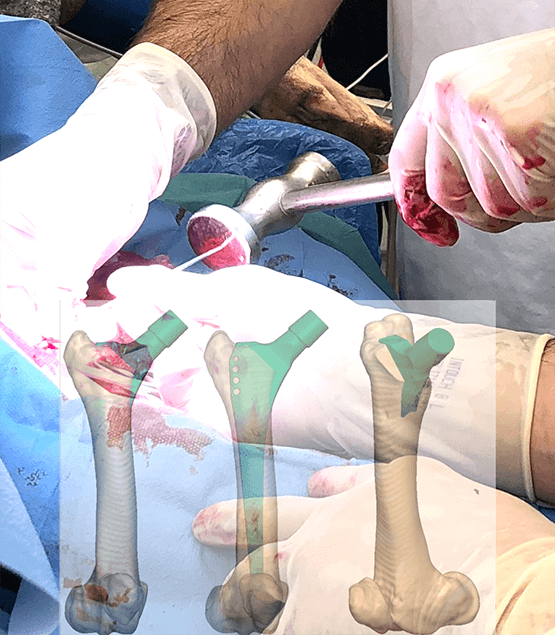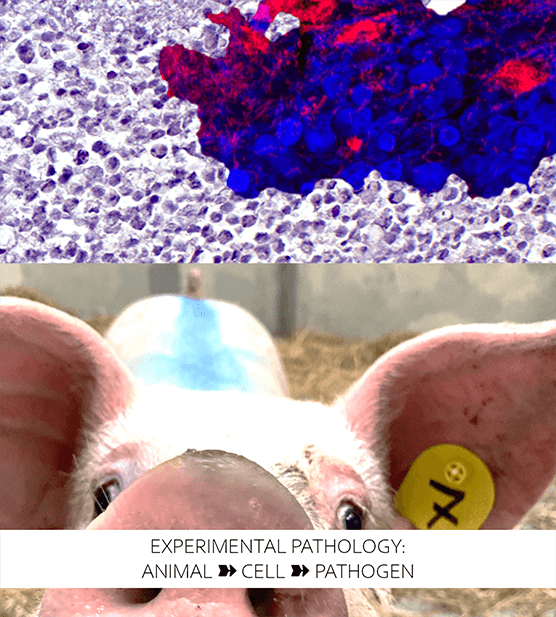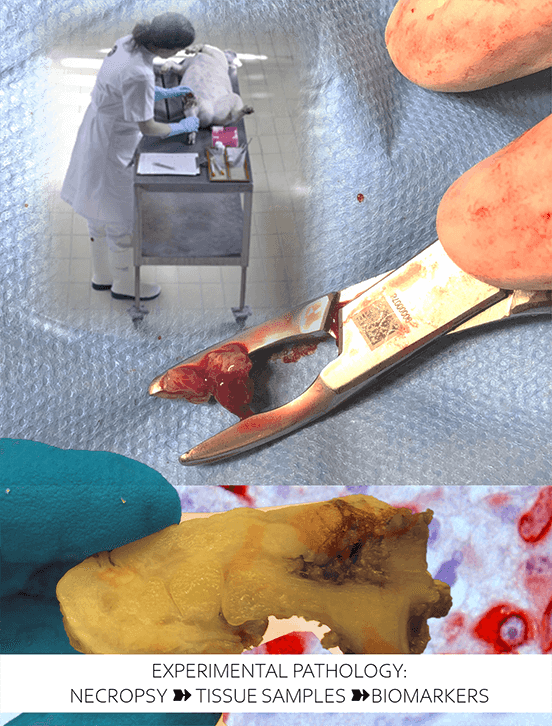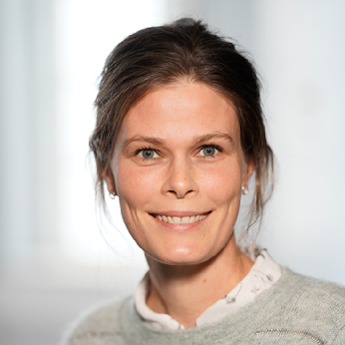Experimental Pathology
Vision and Mission
The research group of Experimental Pathology studies artificially induced, or naturally occurring, pathological processes through macroscopic and microscopic examinations of organs, tissues and cells. The vision is to reveal and visualize disease mechanisms of both human and animal diseases and, thereby, contribute to development of new diagnostic, prognostic, prophylactic and therapeutic technologies. Our missions are:
- To develop animal models of human diseases and characterize them comprehensively through macroscopic and microscopic investigations.
- To apply animal models of human diseases in diagnostic, prognostic, prophylactic and therapeutic studies.
- To use molecular pathology to identify and investigate disease mechanisms in well characterized animal models, or in tissue samples from animals or humans with a specific natural occurring disease of interest.
Research focus
 Currently, the research activities within the research group of Experimental Pathology are focused on bacterial infections related to medical devices and based on porcine models. Because of the large number of patients who receive implanted materials in modern medicine, like pacemakers, artificial joints, bone implants, urine catheters and breast implants, just to mention a few, the number of implant related infections will increase drastically in the future. The collective burden to society of these infections, both in terms of economic costs, antibiotic use, and human suffering, is significant. Therefore, more research into the interaction between bacteria, foreign material and host response is fundamental and urgently needed.
Currently, the research activities within the research group of Experimental Pathology are focused on bacterial infections related to medical devices and based on porcine models. Because of the large number of patients who receive implanted materials in modern medicine, like pacemakers, artificial joints, bone implants, urine catheters and breast implants, just to mention a few, the number of implant related infections will increase drastically in the future. The collective burden to society of these infections, both in terms of economic costs, antibiotic use, and human suffering, is significant. Therefore, more research into the interaction between bacteria, foreign material and host response is fundamental and urgently needed.- The research group of Experimental Pathology works with development, characterization and application of animal models. Macroscopic characterization entails a proper necropsy followed by description of lesions in eviscerated organs. Microscopic characterization entails a morphological description of tissue architecture and cellular responses. Furthermore, pathological molecular techniques must be applied. Molecular pathology entails techniques to visualize tissue structures, cellular expressions (biomarkers) and pathogens in-situ.
- The research group of Experimental Pathology also incorporates the area of comparative pathology which considers human disease processes in comparison to those of other animals. Therefore, biopsies from human patients and collaborations with medical doctors are highly integrated in most of our research projects.
Ongoing research projects
- Minipig model of prosthetic joint infection (PJI)
The main task of the project is to develop a new porcine model for prosthetic joint infection in humans. The model will be used to investigate new antibacterial surface coatings for artificial joints that can aid to prevent infection. The model is based on minipigs with custom made hip implants. The project is a collaboration with Rigshospitalet, University of Athens, The Costertorn Biofilm Center at PANUM, and Ellegaard Göttingen Minipigs.
- Diagnostic and prognostic biomarkers of prosthetic joint infection
The project aims to develop in-situ hybridisation and immunohistochemistry protocols that can identify inflammatory mediators and pathogens within tissue slides. The protocols will be evaluated for their diagnostic and prognostic potential.
- Undersøgelser af peroperativt udtaget materiale i diagnostikken af periprostetiske infektioner - en kohorteundersøgelse
Bone and joint biopsies from patients with prosthetic joint infection and from patients with osteoarthrosis are sampled from different hospitals in the capital region of Denmark. The biopsies will be evaluated with histology. The main goal is to disclose if histology should be included as a standard diagnostic procedure for prosthetic joint infection in Denmark. The project is a collaboration with Rigshospitalet and Gentofte Hospital and The Costertorn Biofilm Center at PANUM.
- Immune stimulation to combat implant related infections
We aim to explore the impact of stimulating the immune system initially in the development phase of implant related infections as an alternative to using antibiotics. The studies will be performed in porcine models. The project is a collaboration with The Costertorn Biofilm Center at PANUM and Montana State University .
- Porous expanding biomimetic scaffolds for the treatment of severe diabetic foot ulcers
We contributes to the development of a new product for local administration of antibiotics. The new product is an injectable gel that can release antibiotics in a controlled manner. The efficacy and pharmacokinetic profile is tested in our porcine model of implant associated osteomyelitis. The project is a collaboration with the Technical University of Denmark (DTU).
- Assessment of antibiotic concentrations in infected tissue
We study how systemic administrated antibiotics penetrates into local foci of infected tissue. The antibiotic concentrations are measured with microdialysis on anesthetized pigs. Microdialysis is a technique which enables sampling form the extracellular fluid. The project is a collaboration with Aarhus University Hospital. See more about this project
- Histology in various projects
Currently, we perform histological analyses for two projects at Syddansk Universitet (SDU). The projects are about the development of an ovine bone infection model and investigation of the impact of urinary catheters on the blader mucosa in a porcine model.
- Jensen N, Jensen HE, Aalbæk B, Blirup-Plum SA, Soto SM, Cepas V, López Y, Gabasa Y, Gutiérrez-del-Río I, Villar CJ, Lombó F, Iglesias MJ, Soengas R, Ortiz FL, Jensen LK. Synthesis of the cyanobacterial halometabolite Chlorosphaerolactylate B and demonstration of its antimicrobial effect in vitro and in vivo. Front Microbiol. 2022 Sep 29;13:950855. doi:10.3389/fmicb.2022.950855.
- Jensen LK, Jensen HE, Blirup-Plum SA, Bue M, Hanberg P, Kvich LA, Aalbæk B, López , Soto SM, Papageorgiou DM, Nikoli E, Arkas M, Gutiérrez-del-Río I, López-Ibáñez S, Villar CJ, Lombó F, Gkomoza P, Kitsou I, Tsetsekou A, Vardavoulias M. Coating of bone implants with silica, hyperbranched polyethyleneimine, and gentamicin prevents development of osteomyelitis in a porcine model. Materialia. 2022, 24, 101473.
- Jensen LK. Implant-associated osteomyelitis: Development, characterization and application of a porcine model. Pathology Microbiology Immunology Scandinavia. 2021, supplementary 141, 129, 1- 44.
- Bue, M. N.L. Bergholt, L.K. Jensen, H.E. Jensen, K. Søballe, M. Stilling, P. Hanberg. Inflammatory proteins in infected bone tissue – an experimental porcine study. Bone Reports, 2020, 13. 100292. https://doi.org/10.1016/j.bonr.2020.100292.
- Blirup-Plum, S.A., B. Aalbæk, H. E. Jensen, T. Bjarnsholt, H. Gottlieb, M. Bue, K. N. Kragh, L.K. Jensen. Pathological and microbiological impact of a gentamicin loaded bio-composite following limited or extensive debridement in a porcine model of osteomyelitis. Bone & Joint Research. 2020, 9, 395-401.
- Lüthje FL, Skovgaard K, Jensen HE, Blirup-Plum SA, Henriksen NL, Aalbæk B, Jensen LK. RANKL is not regulated during chronic osteomyelitis in pigs. J Comp Path. 2020, 179, 7-24.
- Lüthje FL, Blirup-Plum SA, Møller NS, Heegaard PMH, Jensen HE, Kirketerp-Møller K, Gottlieb H, Skovgaard K, Jensen LK. The host response to bacterial bone infection involves a local upregulation of several acute phase proteins. Immunobiology. 2020, 225, 1-10.
- Lüthje FL, Jensen LK, Jensen HE, Skovgaard. The inflammatory response to bone infection – a review based on animal models and human patients. Pathology Microbiology Immunology Scandinavia. 2020, 128, 275-286.
- Jensen LK, Henriksen NL, Blirup SA, Jensen HE. Guideline for preclinical studies of bone infections in large animals based on a systematic review of 316 non-rodent models. Journal of Bone and Joint Surgery. 2019, 101, 1894-1903.
- Jensen LK, Bjarnsholt T, Kragh KN, Aalbæk B, Henriksen NL, Blirup SA, Pankoke K, Petersen A, Jensen HE. In vivo gentamicin susceptibility test for prevention of bacterial biofilms in bone tissue and on implants. Antimicrobial agents and chemotherapy. 2019, 63, 1-10.
- Jensen LK, Henrisken NL, Jensen HE. Guidelines for porcine model of human bacterial infectious diseases. Journal of Laboratory Animals. 2019, 53(2), 125–136.
- Lüthe FL, Skovgaard K, Jensen HE, Jensen LK. Pigs are useful for the study of bone inflammation and regeneration in humans. Journal of Laboratory Animals. 2018, 52(6) 630–640.
- Jensen LK, Henriksen NL, Aalbæk B, Christensen H, Bjarnsholt T, Kragh KN, Jensen HE. Combined staining techniques for demonstration of Staphylococcus aureus biofilm in routine histopathology. Journal of Bone and Joint Infection. 2018, 3, 27-36.
- Bue M, Hanberg P, Koch J, Jensen LK, Lundorff M, Aalbæk B, Jensen HE, Søballe K, Tøttrup M. Single-dose bone pharmacokinetics of vancomycin in a porcine implant-associated osteomyelitis model. Journal of Orthopedic Research. 2018, 36, 1093-1098.
- Jensen LK, Koch J, Tøtterup M, Bue M, Hanberg P, Søballe, Jensn HE. Suppurative inflammation and tissue destruction is associated with reduced penetration of Cefuroxime to acute infected bone implant cavities. Journal of Comparative Pathology. 2017, 157, 308-316.
- Jensen LK, Johansen ASB, Jensen HE. Porcine models of bacterial biofilm infections with focus on pathomorphology. Frontiers in Microbiology. 2017, 8, 1-13.
- Jensen LK, Koch J, Dich-Jorgensen K, Aalbaek B, Petersen A, Fuursted K, Bjarnsholt T, Kragh KN, Tøtterup M, Bue M, Hanberg P, Søballe K, Heegaard PM, Jensen HE. Novel porcine model of implant-associated osteomyelitis: A comprehensive analysis of local, regional, and systemic response. Journal of Orthopedic Research. 2017, 35, 2211-2221.
- Jensen LK, Koch J, Aalbaek B, Moodley A, Bjarnsholt T, Kragh KN, Petersen A, Jensen HE. Early implant-associated osteomyelitis results in a peri-implanted bacterial reservoir. Acta Pathology Microbiology Immunology Scandinavia. 2017, 125, 38-
Contact
Master student in Experimental Pathology
If you are interested in working with large animal models and pathology, you are more than welcome to ask for ongoing projects. A minor part of one of our research projects can always be designed to be your master project.
Email: louise-k@sund.ku.dk
Photos




 Professor Louise Kruse Jensen
Professor Louise Kruse Jensen